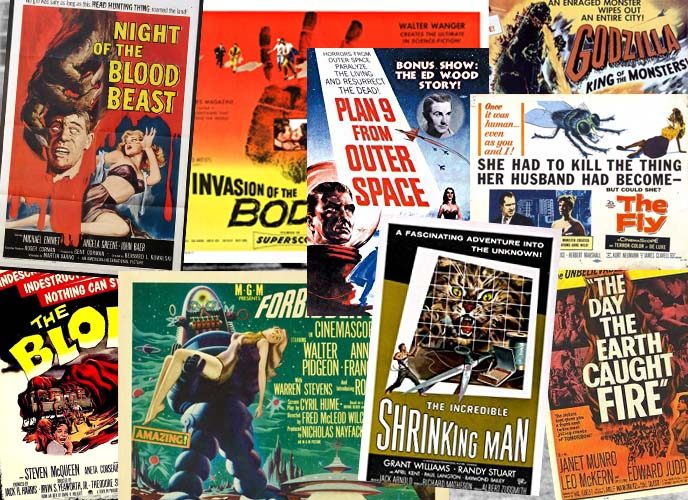The History of ‘50s Science-Fiction Cinema – Part 3.
So far in our hyperspace flight through the history of science fiction films of the 1950s, we’ve seen aliens and monsters, received threats from outer space and promises from intergalactic neighbours, traveled to far off planets and witnessed disembodied Martian heads with the power to control our minds. The threats have been both external and existential and we’ve had truths revealed in ways that only fiction, and science fiction in particular, are capable of revealing. Unfortunately, as the decade entered into its second half the number of quality films produced grew fewer and further apart.
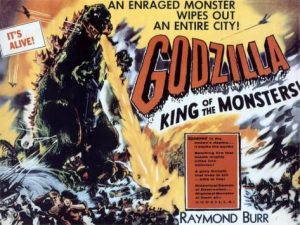 1956 saw the Japanese monster movie Godzilla finally land on US shores. Unfortunately it was with more of a whimper than a roar because the film, Godzilla, King Of The Monsters, wasn’t a new film, or even the original film with subtitles. It was a re-edited version of Hondo’s 1954 masterpiece with a few extra scenes which included Perry Mason actor Raymond Burr, added throughout the film explaining, for an American audience, what was happening. Most of what made the original so interesting was taken out so that all we got was a rather uninteresting shell of a film that had been cobbled together, making it no different from many of the other cheap and nasty productions of the time. We see the monster attacking the cities as it did in the original film but the nuance and the subtext – the fear of nuclear power and its destructive capabilities – were gone. There was no attempt to take it at all seriously and in a number of scenes Burr interacts with some quite obvious lookalikes of the original cast members. What’s more, the Japanese dialogue is muted and replaced with some pretty bad English Language dubbing. All in all this is a version that should only be seen by completists who already have an appreciation of the original, unsullied version.
1956 saw the Japanese monster movie Godzilla finally land on US shores. Unfortunately it was with more of a whimper than a roar because the film, Godzilla, King Of The Monsters, wasn’t a new film, or even the original film with subtitles. It was a re-edited version of Hondo’s 1954 masterpiece with a few extra scenes which included Perry Mason actor Raymond Burr, added throughout the film explaining, for an American audience, what was happening. Most of what made the original so interesting was taken out so that all we got was a rather uninteresting shell of a film that had been cobbled together, making it no different from many of the other cheap and nasty productions of the time. We see the monster attacking the cities as it did in the original film but the nuance and the subtext – the fear of nuclear power and its destructive capabilities – were gone. There was no attempt to take it at all seriously and in a number of scenes Burr interacts with some quite obvious lookalikes of the original cast members. What’s more, the Japanese dialogue is muted and replaced with some pretty bad English Language dubbing. All in all this is a version that should only be seen by completists who already have an appreciation of the original, unsullied version.
Thankfully, there were two bona fide classics released in the months before Godzilla, King Of The Monsters. The first, released on February 5th, was Invasion of The Body Snatchers, easily one of the most famous and beloved sci-fi movies of the decade.
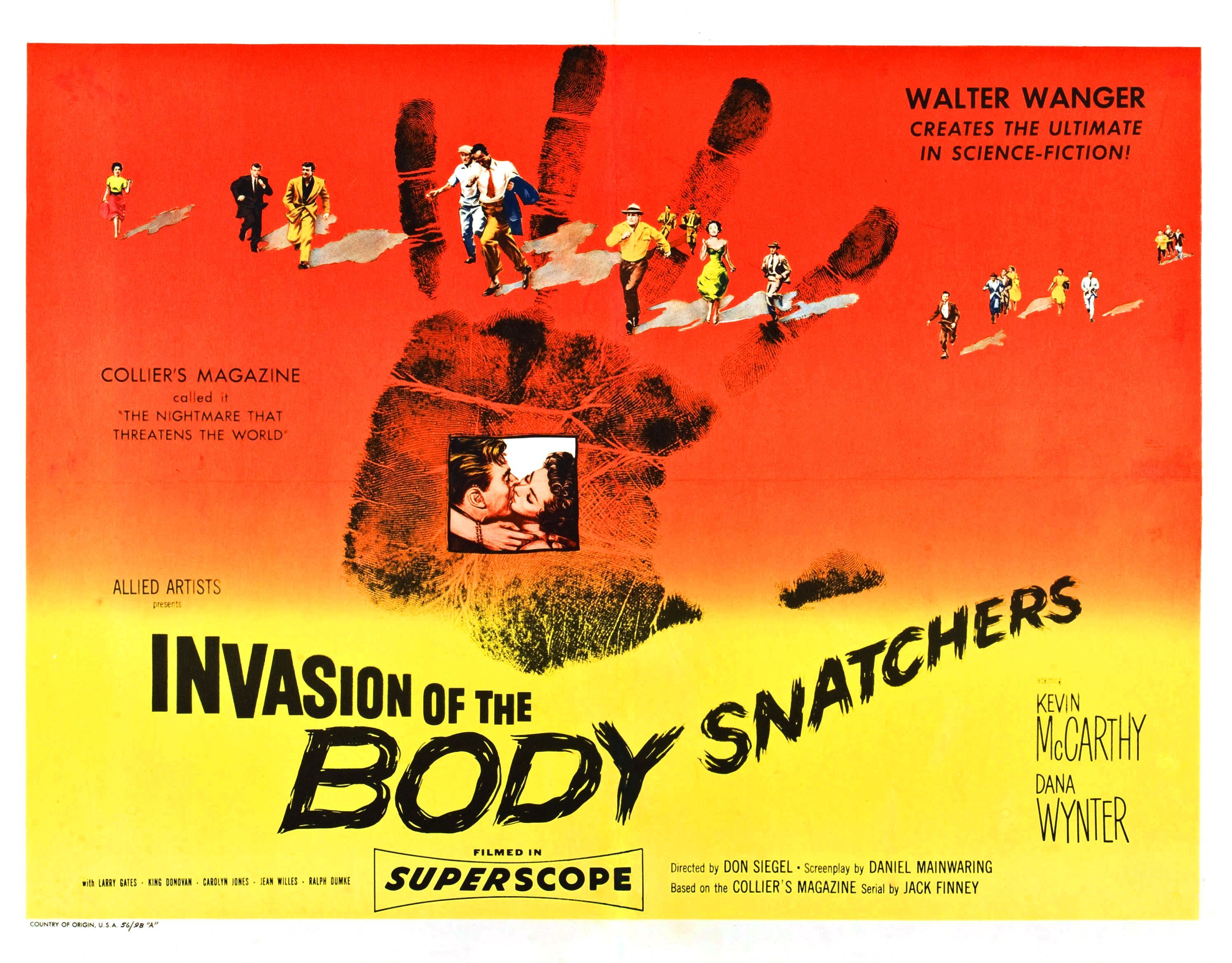
Directed by Don Siegal and based on Jack Finney’s 1954 novel The Body Snatchers, it tells the story of a recently divorced psychiatrist, Dr Miles Bennell (Kevin McCarthy), who on returning to his home town after some time away, is told by a number of friends and patients that their loved ones are no longer the people they once were. No one can be specific as to what is wrong with them, only that something most certainly is. The affected people look the same, act the same and have the same memories, but there is something not quite right with them.
One suspicious character is Bennell’s old flame (a recurring theme in ‘50s sci-fi – think This Island Earth) Becky Driscoll (Dana Wynter) who together with another couple, discover strange looking pods which, when opened, reveal bodies which are slowly absorbing the towns folk and replacing them with identical looking aliens. The process of absorption takes place when the victim is asleep. As the number of towns folk who are changed increases, our heroes race to escape the town before they fall asleep. Suffice to say, the more they run, the more tired they get and the more tense the situation becomes.
There are many strengths to this remarkable film. Firstly, the cast is top notch, especially McCarthy who manages to be both dashing and, at times, heroic whilst also embodying an everyman quality that makes him quite vulnerable. The central idea, that we are most vulnerable when we are asleep, creates some excellent moments of tension especially in the end when Bennell and Driscoll are hiding in a cave, desperately trying to keep awake after being pursued by almost every person in town. It’s a threat that would be explored in a very different way in 1984’s A Nightmare on Elm Street.
The ending, in which Bennell is running down a highway, stopping cars and shouting at the drivers, “They’re here, you’re next, you’re next!“, is iconic and has been used and parodied countless times. McCarthy repeated this scene in the 1978 remake starring Donald Sutherland (it was also remade in 1993 by Abel Ferrara using the name of the novel on which it’s based and The Invasion in 2007 which starred Nicole Kidman).
Perhaps the most intriguing aspects of this film are its themes. Invasion of the Body Snatchers has been used by critics and commentators to represent numerous ideas and themes including the fear of both communism and McCarthyism (two very different extremes), as well as Eisenhower era conformity. What is certain is that the thought that we can be stripped of our personalities and replaced by bland shells still has resonance even today, which may explain why it has been remade so many times. The film was a massive success, grossing over six times its budget and still stands today as one of the most thrilling and chilling films ever made.
Only five weeks after the release of Invasion of the Body Snatchers, another iconic ‘50s sci-fi film which has stood the test of time was released, Forbidden Planet.
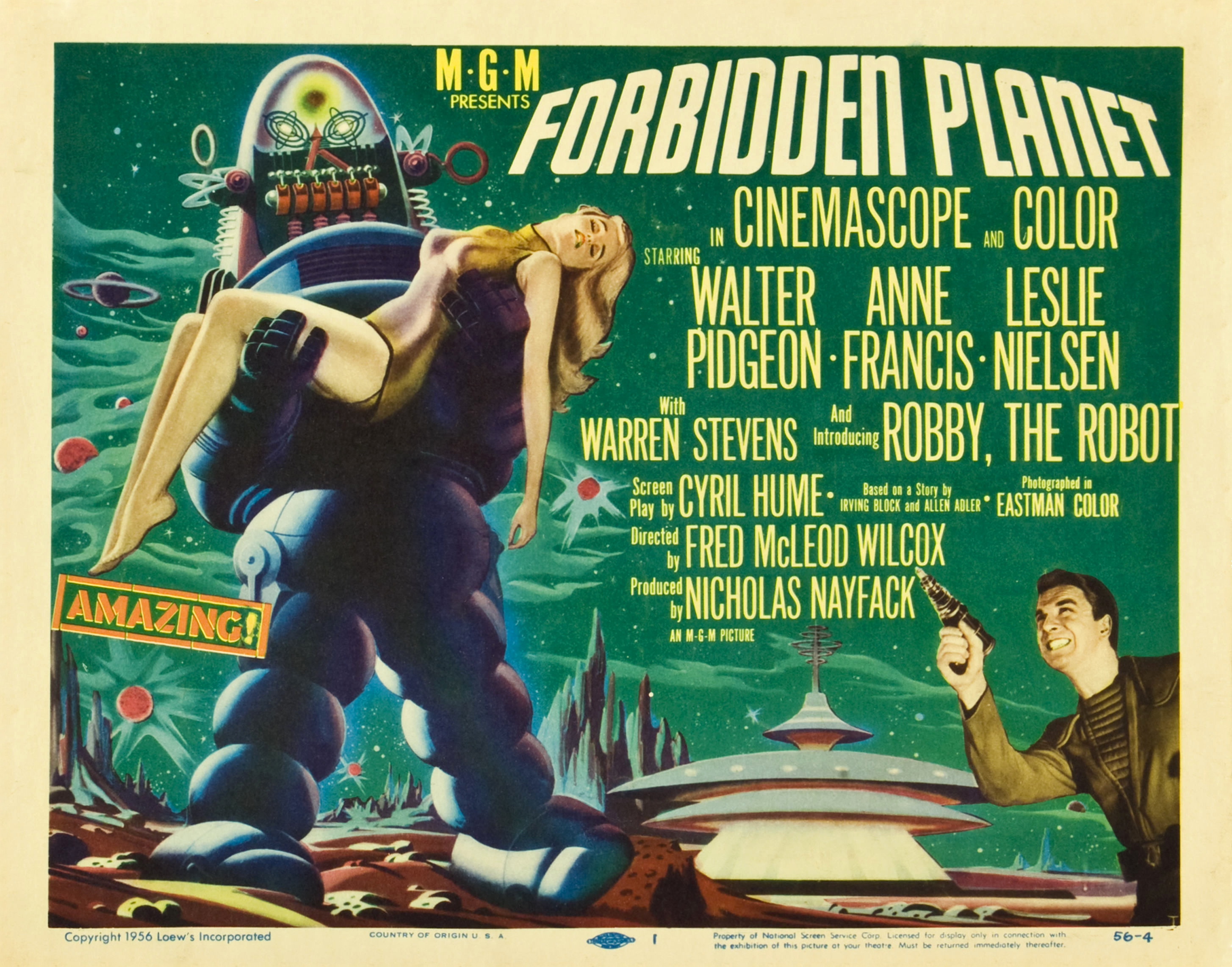
Directed by Fred Wilcox, Forbidden Planet is one of the few films of that era to be set almost entirely in space, mostly on the planet Altair IV and it’s perhaps the most expensive science fiction film of the period costing $1,968,000. It is science-fiction on an epic scale. Made by MGM, it was based on the William Shakespeare play The Tempest and was an attempt by a major studio to legitimise the genre and bring it into the mainstream.
The starship C-57D, captained by Commander John J. Adams (Leslie Nielsen) lands on Altair IV in order to make contact with an expedition that had landed there 20 years earlier. There are now only two people left on the planet, Dr. Edward Morbius (Walter Pidgeon) and his daughter Altair (Anne Francis). The only other inhabitant is Robby The Robot, an artificial intelligence in the form of a six foot plus walking machine.
Morbius has been studying an ancient race called the Krell and had discovered a device called an Educator. He had once used it on himself and, although it almost killed him, it also made him vastly more intelligent.
There’s also something else on Altair IV which threatens the newcomers. An invisible creature which attacks the ship and kills some of the crew. Adams and Altair fall in love and Altair tells her father that she wants to return to earth with the Commander. Tensions are increased when Adams demands that the Krell technology be given to the Earth and not be the domain of one man. Morbius of course refuses stating that “humanity is not yet ready to receive such limitless power”.
One member of the crew, Lieutenant “Doc” Ostrow (Warren Stevens), tries to use the Educator and is killed, but as he dies, he reveals that the Krell were killed not by an outside threat, but by their own base desires. The Educator not only had the power to increase intelligence but also enable the unconscious mind to manifest itself in the form of a violent and terrible monster. The invisible monster that has been attacking the crew is not an inhabitant of the planet, but a manifestation created by Morbius’ id – the part of his psyche in which his anger, his frustrations and his desires reside.
This concept that it is our subconscious being, our true selves, that is our greatest threat is an intelligent and thought-provoking idea which is further proof of how seriously the studio was taking the film. The set design is magnificent but most impressive is Robby The Robot, which cost the production a whopping $125,000. Also impressive is the soundtrack, an electronic ambient score composed by Bebe and Louis Barron. Forbidden Planet did manage to make a profit but wasn’t the blockbuster that the studio had hoped for (it grossed less than Invasion of the Body Snatchers) but it’s still lauded today as one of the greatest science fiction films of all time.
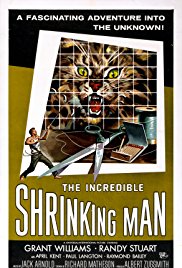 As the decade started to draw to a close, fewer quality films were being made. There were a huge number of sci-fi films released in 1957 but only one true classic. Once again, we can thank the great Jack Arnold who directed The Incredible Shrinking Man. It’s a film which returned to the theme of the unknown dangers of nuclear power. Scott Carey (Grant Williams) is out on a boat one day when he passes through a strange fog. At first the only thing that seems to have happened to him is that the fog left a shiny sheen on his skin but later he notices that his clothes are getting too large for him. Initially it’s thought that he’s just losing a little weight, but his doctor decides to take two x-rays, a week apart. They confirm that Scott is indeed shrinking. The reason The Incredible Shrinking Man works so well is because it doesn’t isolate itself by focusing entirely on the man and the science fiction. It also focuses on the effects of the shrinking on his personal and professional life. He loses his job and sells his story to the newspapers. Gawkers camp out on his lawn hoping to get a glimpse of him. He becomes friends with a small person who performs in a carnival but soon he becomes even smaller than she is.
As the decade started to draw to a close, fewer quality films were being made. There were a huge number of sci-fi films released in 1957 but only one true classic. Once again, we can thank the great Jack Arnold who directed The Incredible Shrinking Man. It’s a film which returned to the theme of the unknown dangers of nuclear power. Scott Carey (Grant Williams) is out on a boat one day when he passes through a strange fog. At first the only thing that seems to have happened to him is that the fog left a shiny sheen on his skin but later he notices that his clothes are getting too large for him. Initially it’s thought that he’s just losing a little weight, but his doctor decides to take two x-rays, a week apart. They confirm that Scott is indeed shrinking. The reason The Incredible Shrinking Man works so well is because it doesn’t isolate itself by focusing entirely on the man and the science fiction. It also focuses on the effects of the shrinking on his personal and professional life. He loses his job and sells his story to the newspapers. Gawkers camp out on his lawn hoping to get a glimpse of him. He becomes friends with a small person who performs in a carnival but soon he becomes even smaller than she is.
The special effects are once again extraordinary especially in the second half of the film when Scott has to confront a cat who attacks him in a doll’s house which he has made into his home and a spider (which looks mysteriously like a tarantula). It is ultimately a melancholy film without any hope. As Scott continues to shrink to microscopic levels and beyond, we aren’t given any form of redemption or victory. Instead Scott must just accept the inevitable, wherever that takes him, and as the film draws to a close, we are left moved at his misfortune and the hopelessness of his plight.

Unfortunately nothing else in 1957 could live up to The Incredible Shrinking Man, or even come close for that matter. The titles may have promised a lot but most of the films of that year were far from good. Films like The Amazing Colossal Man (basically the premise was the opposite of the Incredible Shrinking Man), The Monster That Challenged the World (a so-so film that fails to challenge its audience) and The Giant Claw which features one of the most ludicrous monsters of all time (basically a giant turkey – the creature and the film) were some of the lowlights.
1958 wasn’t a classic year either but it did have three good, if not great sci-fi films that are still, quite rightly, remembered today.
In August of that year there was The Fly. Remembered mostly for its subtle humour – “Helene and Andre believed in the sacredness of life. They wouldn’t harm anything… not even a fly”. A fly gets caught in a machine as it‘s teleporting a scientist (André Delambre played by David Hedison) who returns with a fly’s head on his body and his head on a fly’s body.
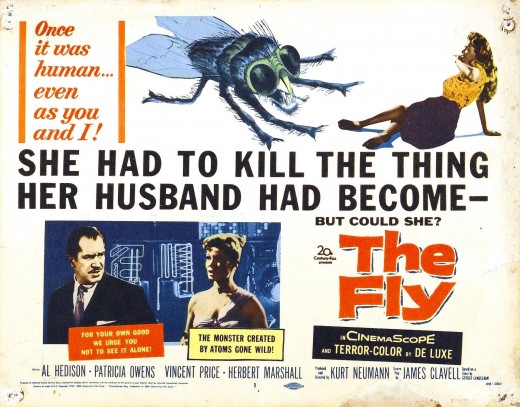
Andre (the human body version) reveals himself to his wife, Hélène Delambre (Patricia Owens) and together they try to find the fly with a human head in the hope that he can reverse the process. Unfortunately the fly’s instincts start taking over and Andre eventually convinces his wife to kill him, which she does using a large hydraulic press at his factory. The police hear her confession and declare that she has gone mad and charge her with murder. In the meantime, Andre’s brother François (wonderfully played by Vincent Price) says that he had seen a strange looking white-headed fly. He and the police look for it and find it stuck to a cob web about to be devoured by a spider. The head does indeed belong to the now deceased Andre and, as the spider gets closer, it cries out “Help me, Help me.’” But instead of saving the stricken fly/human hybrid, the policeman picks up a rock and crushes the creature. The Fly was a huge success and helped turn Vincent Price into a star.
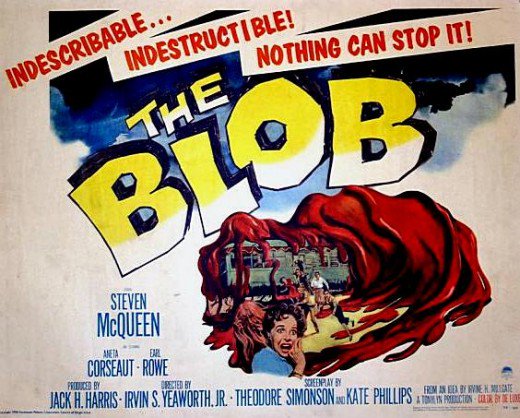
The second film of note from 1958 was released in September and featured a young Steve McQueen (although at 28, he was still much older than the teenager he played). It’s an alien invasion film with a difference. The alien in question comes in the shape of a red blob which consumes every living thing it comes in contact with, growing in size with each meal. It was made cheaply and does, for the most part, transcend its budgetary restrictions to become much better than it could, or indeed, should have been. It is not however a great film. It does have a sense of humour, which is important and ends on a note which is perhaps more prescient today than the writers would have ever thought back in 1958. The blob is frozen, rendering it inert and then taken and dumped in the Artic. One of the characters says: “At Least we’ve got it stopped”, to which Steve McQueen then replies ”Yeah, as long as the Arctic stays cold.’” Who knows, maybe the effects of global warming will see the Blob reawaken, ready to consume us once more.
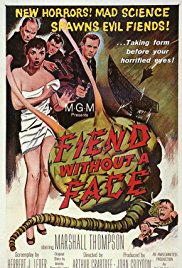 The last notable release that year was Fiend Without A Face, very low budget film which is actually quite entertaining. It’s also a very gory film which shocked many critics at the time and received an X certificate in the UK. It’s another alien invasion film, this time the monsters look like brains with tails, but don’t let that put you off. The special effects are excellent and the ending is really quite thrilling. It has even received a Criterion Collection release in the US. Perhaps one of the more famous sci-fi films released that year was Attack Of The Fifty Foot Woman. It is a truly awful film which somehow is still entertaining – just don’t expect it to stand up to repeated viewings.
The last notable release that year was Fiend Without A Face, very low budget film which is actually quite entertaining. It’s also a very gory film which shocked many critics at the time and received an X certificate in the UK. It’s another alien invasion film, this time the monsters look like brains with tails, but don’t let that put you off. The special effects are excellent and the ending is really quite thrilling. It has even received a Criterion Collection release in the US. Perhaps one of the more famous sci-fi films released that year was Attack Of The Fifty Foot Woman. It is a truly awful film which somehow is still entertaining – just don’t expect it to stand up to repeated viewings.
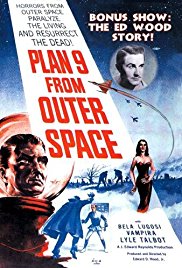 I would like to say that in 1959 the decade ended with a bang, a masterpiece that summed up the decade, that illustrated all that was great about this wonderful period in film history. Unfortunately I can’t. 1959’s most notable film is undoubtedly known because of its awful production values, nonsensical plot and a glaring change of actor half-way through. The film is Ed Wood’s Plan Nine From Outer Space, a film so bad it has become legendary. The plot is all over the place, the sets are cheap and the cast is an outrageous list of freaks and outsiders. Included in this cast was the great Bela Lugosi who, half way through production, unfortunately died. But Ed Wood wasn’t put off. He replaced Lugosi with his personal chiropodist, a man who was much taller and younger than Lugosi, had a full head of hair (Lugosi was balding) and looked nothing like the legendary actor at all. To fix this, Wood had the newcomer cover his face with a cloak for the remainder of the movie. While it’s a terrible film, it is one that just has to be seen to be believed. Once you’ve seen it, make sure you look out for Tim Burton’s wonderful Ed Wood with Johnny Depp in perhaps his greatest role and Martin Landau in Oscar winning form as Bela Lugosi.
I would like to say that in 1959 the decade ended with a bang, a masterpiece that summed up the decade, that illustrated all that was great about this wonderful period in film history. Unfortunately I can’t. 1959’s most notable film is undoubtedly known because of its awful production values, nonsensical plot and a glaring change of actor half-way through. The film is Ed Wood’s Plan Nine From Outer Space, a film so bad it has become legendary. The plot is all over the place, the sets are cheap and the cast is an outrageous list of freaks and outsiders. Included in this cast was the great Bela Lugosi who, half way through production, unfortunately died. But Ed Wood wasn’t put off. He replaced Lugosi with his personal chiropodist, a man who was much taller and younger than Lugosi, had a full head of hair (Lugosi was balding) and looked nothing like the legendary actor at all. To fix this, Wood had the newcomer cover his face with a cloak for the remainder of the movie. While it’s a terrible film, it is one that just has to be seen to be believed. Once you’ve seen it, make sure you look out for Tim Burton’s wonderful Ed Wood with Johnny Depp in perhaps his greatest role and Martin Landau in Oscar winning form as Bela Lugosi.
The best sci-fi film of 1959 is undoubtedly On The Beach, a big budget star vehicle with Gregory Peck, Ava Gardner, Anthony Perkins and Fred Astaire but it’s a very different film from the genre films that had preceded it. This is a serious attempt to show the impact of nuclear war – not with monsters or aliens but with romance. It is undoubtedly an interesting film but can barely be included as part of this wonderful genre.
There would still be many science-fiction films made in the 1960s starting with Eyes Without a Face in 1960 and ending with Planet of the Apes in 1968 but the era of classic science-fiction was over, replaced by schlocky, drive-in fare that had become increasingly popular throughout the ‘50s, and, very occasionally, bigger budget, more contemporary films like Planet of The Apes. There were a few which, although made in the ‘60s felt like the very best of the ‘50s – The Day The Earth Caught Fire (1961), The Day of the Triffids (1962) or The Man With the X-Ray Eyes (1963) but these were a dying breed. In fact, the changes in genre films around this time reflects the changes in Hollywood, the end of the classic era and the emergence of the independent and European influenced era.
The 1950s was a very special time for cinephiles. It was a decade that produced a large number of quality genre films, a feat that wouldn’t be repeated until the mid 1970s, and the birth of the blockbuster era. This is somewhat ironic of course, given that many of the ‘50s greatest genre films where made cheaply and sometimes, independently. However, I very much doubt whether many of the genre films of the 1980s would have been what they were if it wasn’t for the films listed above. After all, it was the children of the ‘50s, those who watched The Incredible Shrinking Man, Invasion of the Body Snatchers, This Island Earth, The Thing from Another World and so much more, who stood behind the camera three decades later and shouted ‘Action’.
You can read Part One here:
And Part Two here:

